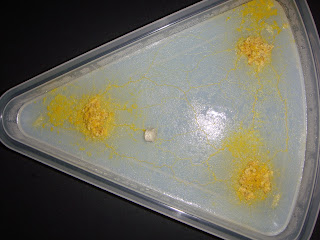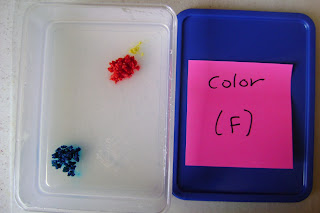The following 3 experiments were 'mock' robotic scenarios carried out over the past 7 days. Our purpose was to investigate what causes the mold to change its growth patterns. How can we control the movement of the mold?
First we conducted a Directional test. The mold was placed at one end of a horizontal path of food. It followed this path until it consumed the entire pile. Instead of branching out towards the other pile of food near the top of the dish, it produced growth in all directions. Even after finding the second pile of food, the mold continued to accumulate on the opposite side of the dish. Towards the end of the week, the mold concentrated its growth in the direction of the second pile of food. Perhaps the mold can be trained in this way. However, it is undesirable that the mold branches out in all directions before concentrating growth in the preferred direction.
Below are the results of the Repellent test. Mold shows a strong aversion to the sleeping pills. It seems that even pill residue inhibits growth. When pills were moved from the right to left side near the mold, it grew the opposite direction and literally moved itself to the other side of the dish. The pills are such strong repellents that the mold has not growth enough to interact with the sea salt that was placed in the center of the dish. Pills are effective repellents but slightly undesirable because they severely restrict growth.
A Scrape test was also conducted. This petri dish previously held several piles of food and mold growth throughout the entire area. All mold cells and pieces of food were scraped off the agar surface and deposited in a line at the bottom end of the dish. Mold has since regrown and is now expanding upwards to fill the rest of the container. However, several tiny bits of mold that were left on the surface have begun to grow in the upper area of the surface, interfering with the desired aesthetic. Proper results can be obtained by designing a scraping device that is able to remove all mold from the surface.
Other findings:
After filling out the entire petri dish, mold will grow vertically. However, since there is no agar solution on the sides of the dish, the mold grows in a different pattern. In the absence of agar, mold cannot grow fine tendrils and instead clumps together in larger masses. The patterns are just as beautiful.
Another investigation of vertical growth patterns. A hole was dug out of the agar to remove a growth of common mold that had gotten into the dish. The hole is in the mold's area of dense fractal growth, however, the growth in the hole seems to be even more dense. Further study can be done by observing growth in a petri dish with 'hills and valleys' in the agar.
Results of the color test over the past 4 days:
...and a close-up showing the color gradient apparent in the main arteries. New growth is yellow.




































